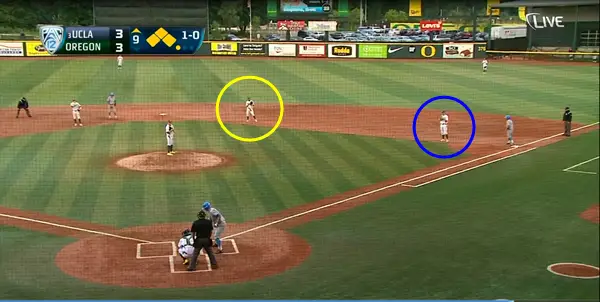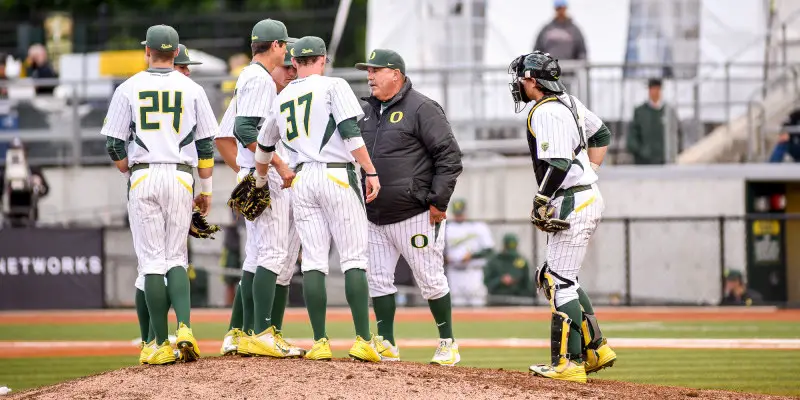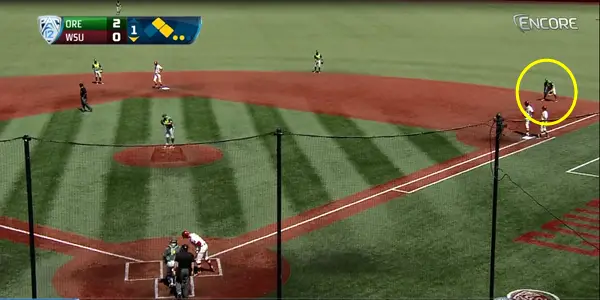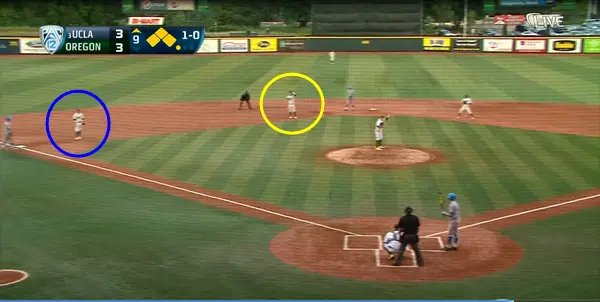Defensive positioning in baseball has changed dramatically over the years as managers are looking at every detail of the game. Getting advanced statistics on batters and shifting players into the correct defensive positions are a few examples. The defensive shifts implemented during the game can be interesting to see for fans – new and old — of baseball.
In my last baseball analysis, I broke down two defensive positioning shifts: Normal Depth and Double Play Depth. Continuing with defensive positioning, I will break down two more defensive shifts Oregon head coach George Horton elects to use: Infield-In Depth and No- Doubles Depth.
No-Doubles Positioning
In my last analysis, I broke down the positioning of normal depth. No-Doubles positioning is similar except for the positions the first and third basemen take.
The corner infielders are the primary change from the image above. Coach Horton will elect this positioning for opponents to hit only singles and not be able to stretch the single into a double. Coach Horton may also use this positioning if the team is leading by a few runs towards the end of the game.
For the corner infielders, their positioning will be closer to the foul line by a couple feet. Notice Scott Heineman – yellow circle, above – is already in position. Mitchell Tolman, not shown, is also occupying the same relative position on the third base side. In general, Heineman and Tolman are in normal depth positioning from where the other infielders are standing but playing closer to the foul lines.
Note: Playing closer to the foul line creates a bigger gap between the infielders on both sides. While not shown in the image, the outfielders are playing back in the outfield. This means more ground to cover for the shortstop and second baseman if a fly ball occurs.
Infield-In Positioning
With the bases loaded for UCLA and one out, coach Horton elects to bring his infielders in. For this positioning, the players stand where the infield grass meets the infield dirt. The purpose is to prevent the runner at third from scoring. The play is to be made at home for the out.
If you look at the left side of the infield, shortstop Mark Karaviotis — yellow circle, above — positions himself on the edge of the infield grass. Karaviotis also positions himself away from second base. Third baseman Mitchell Tolman — blue circle, above — plays away from third base and stands near the edge of the infield grass.
 On the right side of the infield, the two infielders appear almost identical in positioning with the left side. Second baseman David Patzlaff — yellow circle, above — stands close to the infield grass and away from second base. First baseman Scott Heinemen — blue circle, above — positions himself away from first base and in toward the infield grass.
On the right side of the infield, the two infielders appear almost identical in positioning with the left side. Second baseman David Patzlaff — yellow circle, above — stands close to the infield grass and away from second base. First baseman Scott Heinemen — blue circle, above — positions himself away from first base and in toward the infield grass.

Nice play …
With no room for error, the GIF shows Tolman fielding a grounder cleanly and throwing to catcher Tim Susnara for the out at home — not quite the double play the Ducks were hoping to turn, but a critical out in the game. With the second out being made, the Ducks will have the infield in normal depth positioning.
Note: Having the infielders play in with the bases loaded gives little reaction time. Players have to be on their toes and ready for the ball to come their way. Hesitancy for a brief instant could result in the ball going by to the outfield.
When the game is on the line, coach Horton will elect the best defensive shift for the Ducks depending on the situation. The four shifts I have broken down in these analyses are pivotal on the diamond to prevent opponents from scoring runs. The season may be at an end but look for these shifts next season as the Ducks “Win the Day” on the diamond.
Top Photo by Craig Strobeck
Related Articles:
Oregon Enters Playoffs Better Off Than Last Year
Will The Coaching Carousel Kill Oregon's CFP Chances?
The Playoff Formula Hasn't Changed
Oregon Aims to Bury Dawgs, Punch Playoff Ticket in Rivalry Clash
Huskies Are the New Beavers, Stay In Your Lane Kiffin, and the Civil Apple Cup War
Oregon Football: The X-Factor Vs. Washington
My name is Andrew Bet and I am currently a Journalism student at the University of Oregon. Born in Bethlehem, PA and raised in San Mateo, California it was easy for me to kindle an interest in sports considering all the college and professionals teams who call the Bay Area home. Some of the teams I enjoy following are the University of Oregon, Stanford, San Francisco Giants, San Jose Sharks, Oakland A’s, San Jose Earthquakes, Philadelphia Eagles and Flyers and the European Soccer League. During my youth, I played soccer and baseball. Today, I enjoy playing golf and bowling. My dream is to combine writing and my passion for sports and become a sports writer for one of my favorite teams. Follow me on Twitter: @ACB_Ducks12



